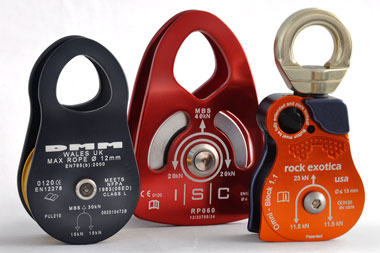Short answer: NO.
Treetools does not recommend the use of large-eye, general purpose or rescue pulleys for remote applications in the tree.
By 'large-eye' we mean any pulley with a connection point large enough for a carabiner to make a full rotation without resistance from the barrel - see three large-eye pulley examples below.
Recently a climber demonstrated his home-made redirect to us (of which he was very proud).
Without wishing to douse his enthusiasm Treetools suggested replacing the general purpose large-eye pulley with a 'personal' small-eye pulley to help reduce (or eliminate altogether) the chance of cross loading the carabiner at the anchor point.
What's your point Treetools?
The climber in question could not see the point of our argument. And, in any case the large-eye pulley had a superior bend ratio at the sheave.
In his opinion swivels have a large-eye and most bridge attachment points allow for full rotation of the carabiner (some tree climbers even prefer it that way).
True.
But a bridge swivel or ring is right at hand should you notice a carabiner cross-load mid climb - and you can easily remedy the problem.
Now if the cross-load happens to be at the canopy anchor point, perhaps many meters from where you are currently located in the tree - you have an entirely different problem on your hands.
It is simply a matter of best practice - don't use a large-eye pulley in a climbing configuration where the potential for cross-loading is high.
Particularly if you are not at hand to fix the problem immediately!
Personnel small-eye pulleys like the DMM Pinto, Pinto Rig , ART Cocoon, Petzl Fixe etc for pulley-based rope savers please - don't risk remote cross-loading with a large-eye pulley - it's not worth it.

